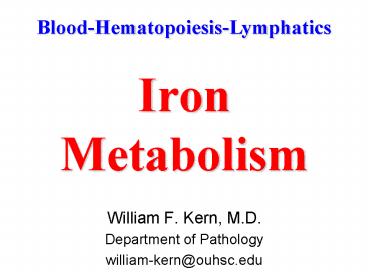Iron Metabolism - PowerPoint PPT Presentation
1 / 23
Title: Iron Metabolism
1
IronMetabolism
Blood-Hematopoiesis-Lymphatics
- William F. Kern, M.D.
- Department of Pathology
- william-kern_at_ouhsc.edu
2
Downloading any of the images, photographs or
diagrams from this presentation for any purpose
other than studying is prohibited.
3
Iron
- Essential component of heme ring
- Hemoglobin, myoglobin, some enzymes
- Iron also required for some other enzymes
- Mediates electron exchange also O2 carrier
- Abundant in nature
- Mostly ferric (Fe3) form insoluble at neutral
pH - Potentially toxic
- Generation of reactive oxygen species
4
Regulation of Iron Stores
- Iron stores regulated by absorption
- Iron absorption can be increased to some extent
- in states of iron deficiency - Iron absorption decreases in states of iron
sufficiency or overload - No physiologic way to significantly increase iron
excretion - Obligate iron loss 1 mg/day (2 mg/day for
menstruating woman)
5
Control of Iron Absorption
6
Control of Iron Absorption
- Stores regulator Dependent on iron stores
- Absorption inversely proportional to body iron
stores - Erythropoiesis regulator Driven by
erythropoiesis in marrow - Increased erythropoiesis effective or
ineffective increases iron absorption - Can override stores regulator
- Chronic increase in erythropoiesis (effective or
ineffective) can result in iron overload
7
Iron Metabolism StorageKey Players
- Transferrin Iron transport molecule in blood
- Transferrin receptor (TfR) Cell surface receptor
required for iron uptake - Ferritin Primary iron storage molecule
- Predominantly present in cells small amount
present in blood - Hepcidin Primary iron regulatory molecule
8
Iron Absorption
- Iron absorption occurs predominantly in duodenum
- Iron in the diet comes in two forms heme iron
and non-heme iron - Non-heme iron is predominantly in ferric form
(Fe3) Must be converted to ferrous (Fe2) form
to be absorbed - Heme iron is readily absorbed into enterocyte
9
Iron Absorption
10
Factors that Influence Iron Absorption
Decrease
Increase
- Decreased gastric acidity
- Phytates in grains
- Tannates in tea
- Phosphates
- Some vegetable proteins
- Cows milk proteins
- Ascorbic acid
- Human breast milk
11
Iron Absorption
- Normal 1-2 milligrams/day Balance iron loss
- Maximum iron absorption on normal diet 4 mg/day
12
Regulation of Iron Transport Storage Molecules
- Synthesis of key molecules (transferrin,
ferritin, etc.) regulated by intracellular iron
level - Intracellular iron binds to iron regulatory
proteins (IRPs) - IRPs bind to iron responsive elements (IREs) on
mRNA - IRPs can result in increased or decreased protein
synthesis
13
Regulation of Iron-Related Molecules
Downloaded from Hoffman Hematology Basic
Principles Practice
14
Regulation of Iron-Related Molecules
5 Iron allows transcription
3 Iron blocks transcription
Downloaded from Hoffman Hematology Basic
Principles Practice
15
Body Iron Stores
70 kg man 60 kg woman
Iron stores - Transferrin, ferritin, hemosiderin 1.4 grams 0.3 grams
Hemoglobin 2.5 grams 1.9 grams
Myoglobin 0.14 grams 0.13 grams
Heme Enzymes 0.01 grams 0.01 grams
Total 4.05 grams 2.34 grams
Data from Schrier, SL Scientific American
Medicine, Scientific American, 1995
16
The Iron Cycle
Downloaded from Hoffman Hematology Basic
Principles Practice
17
Hepcidin
- Key regulatory molecule of iron metabolism
- Produced by HAMP gene in liver
18
Hepcidin Effects
- Blocks iron export from cells
- Binds to and degrades ferroportin
- Blocks iron absorption from enterocytes in
duodenum - Blocks iron release from macrophages
- Decreases serum iron
- Blocks iron transfer to RBC precursors in marrow
19
Control of Hepcidin Synthesis
- Hepcidin synthesis decreased by iron deficiency,
hypoxia, increased erythropoiesis - States of possible increased iron need
- Hepcidin synthesis increased by inflammatory
cytokines, iron overload
20
Control of Hepcidin Synthesis
- Control mechanisms complex
- Multiple proteins involved
- HFE
- Hemojuvelin
- Transferrin receptor 2 (TfR2)
- Deficiency of some of these results in
hemochromatosis due to deficient hepcidin
synthesis
For reference only.
21
Markers of Iron Status
- Serum iron level
- Transferrin level
- Sometimes reported as total iron binding capacity
(TIBC) - Transferrin saturation ()
- Often reported as iron TIBC x 100
- Serum ferritin
You need to know these, and how to interpret them.
22
Markers of Iron Status
- Iron level Decreases with iron deficiency and
also inflammation - Transferrin Increases in iron deficiency
decreases with inflammation - Transferrin saturation Typically decreases in
iron deficiency and inflammation - Ferritin Decreases in iron deficiency increases
in inflammation
You need to know this.
23
Iron Indices
Transferrin (TIBC)
Sat
Ferritin
Serum Iron
Iron Deficiency
Inflammation
Combined
?
?
Patient with iron deficiency and inflammatory
condition Saturation () Iron TIBC x 100
TIBC measure of transferrin concentration in
plasma

